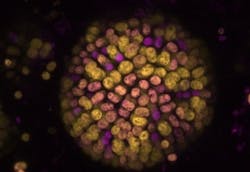New type of photosynthesis uses near-infrared rather than red light
The vast majority of life on Earth uses visible red light in the process of photosynthesis, but a new type of photosynthesis uses near-infrared light instead. The discovery, published in Science, was led by Imperial College London, supported by the BBSRC, and involved groups from the ANU in Canberra, the CNRS in Paris and Saclay, and the CNR in Milan. The new process was detected in a wide range of cyanobacteria (blue-green algae) when they grow in near-infrared light, found in shaded conditions like bacterial mats in Yellowstone and in beach rock in Australia.
RELATED ARTICLE: Visible-light photoreactor uses photosynthesis to convert CO2 to clean air and fuel
As scientists have now discovered, it also occurs in a cupboard fitted with infrared light-emitting diodes (LEDs) in Imperial College London. The standard, near-universal type of photosynthesis uses the green pigment, chlorophyll-a, both to collect light and use its energy to make useful biochemicals and oxygen. The way chlorophyll-a absorbs light means only the energy from red light can be used for photosynthesis.
Since chlorophyll-a is present in all plants, algae and cyanobacteria that we know of, it was considered that the energy of red light set the 'red limit' for photosynthesis; that is, the minimum amount of energy needed to do the demanding chemistry that produces oxygen. The red limit is used in astrobiology to judge whether complex life could have evolved on planets in other solar systems.
However, when some cyanobacteria are grown under near-infrared light, the standard chlorophyll-a-containing systems shut down and different systems containing a different kind of chlorophyll, chlorophyll-f, takes over. Until now, it was thought that chlorophyll-f just harvested the light. The new research shows that instead chlorophyll-f plays the key role in photosynthesis under shaded conditions, using lower-energy infrared light to do the complex chemistry. This is photosynthesis 'beyond the red limit'.
Lead researcher professor Bill Rutherford, from the Department of Life Sciences at Imperial, said, "The new form of photosynthesis made us rethink what we thought was possible. It also changes how we understand the key events at the heart of standard photosynthesis. This is textbook changing stuff."
Dennis Nürnberg, the first author and initiator of the study, said, "I did not expect that my interest in cyanobacteria and their diverse lifestyles would snowball into a major change in how we understand photosynthesis. It is amazing what is still out there in nature waiting to be discovered."
SOURCE: Imperial College London; https://www.imperial.ac.uk/news/186732/new-type-photosynthesis-discovered/
About the Author

Gail Overton
Senior Editor (2004-2020)
Gail has more than 30 years of engineering, marketing, product management, and editorial experience in the photonics and optical communications industry. Before joining the staff at Laser Focus World in 2004, she held many product management and product marketing roles in the fiber-optics industry, most notably at Hughes (El Segundo, CA), GTE Labs (Waltham, MA), Corning (Corning, NY), Photon Kinetics (Beaverton, OR), and Newport Corporation (Irvine, CA). During her marketing career, Gail published articles in WDM Solutions and Sensors magazine and traveled internationally to conduct product and sales training. Gail received her BS degree in physics, with an emphasis in optics, from San Diego State University in San Diego, CA in May 1986.
